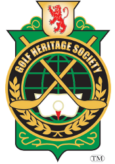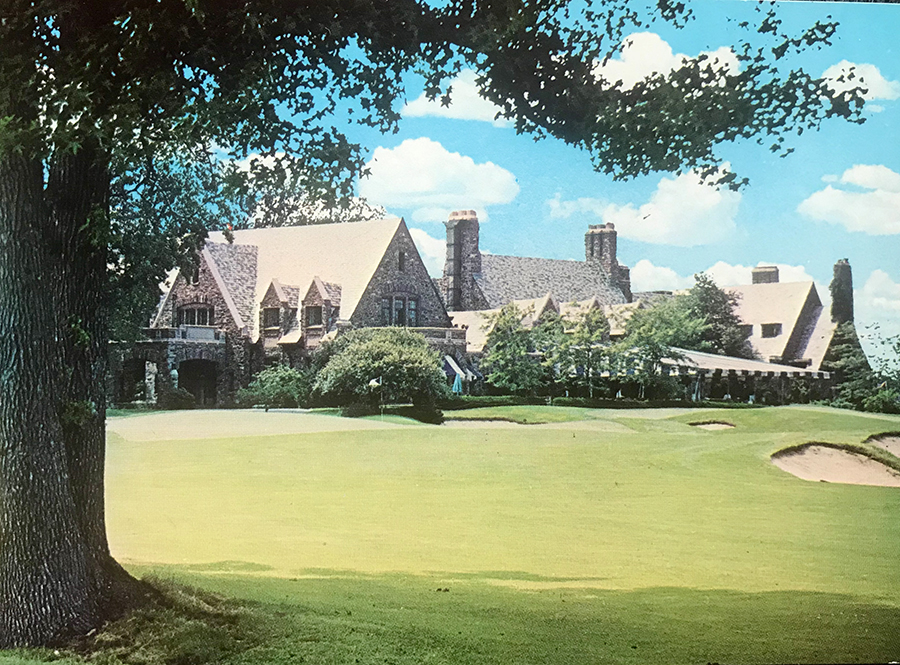
By George Petro
Fitness and distance are much discussed by golfers these days. Particularly with the success of Bryson DeChambeau at Winged Foot. Love him or not, DeChambeau bested a beast of a course. (Statistics included below.) He has been both excoriated and lauded for his attention to muscle mass and the distance this has given him, which put me in mind of an earlier fitness-minded golfer, Frank Stranahan.
The son of the founder of Champion Spark Plug Co., he was perhaps the best amateur golfer immediately post-WWII. He was first mentored by Byron Nelson, the head professional at Inverness in Toledo, Ohio, Stranahan’s home town. Fellow competitors said he “was experimenting too much with his swing,” and chided him for traveling to tournaments with his weight lifting equipment. He likely influenced his friend, Gary Player, in the South African’s devotion to physical fitness.
From John Behrend’s 1995 book, The Amateur, we learn that Stranahan believed health:
“…was fundamental to sporting success and this meant no smoking or alcohol, a strict diet and rigorous exercise. “You need length to be a winner” he said, so weight lifting apparatus was always a part of his championship baggage…”
Arnold Palmer, who referred to his friend as “Muscles,” said, “He used to carry his weights in a suitcase. He’d get the bellman to carry the luggage to his room, but it was so heavy they couldn’t lift it.”
As with DeChambeau, people of Stranahan’s day thought his power lifting, etc. would be the ruin of his game. He wasn’t tall, but very muscular for his size and became known as the “Toledo Strongman,” reportedly having ranked as the No. 1 powerlifter in the country for his weight class from 1945-54, winning National competitions into his 70s. After retiring from golf, he competed in no fewer than 102 Marathons. He passed away in 2013 at age 90.
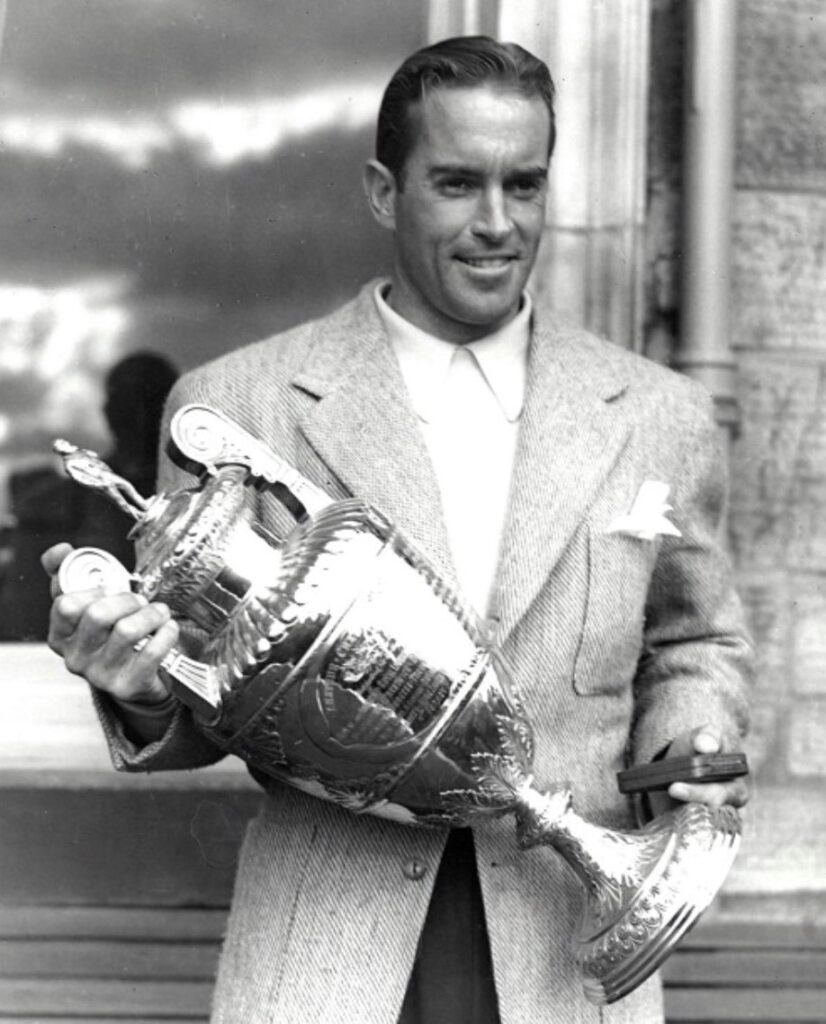
Instead of ruination, the fitness routines did nothing to harm his game. His amateur victories included the 1948 and 1950 British Amateur, four Western Amateurs, three North and South Amateurs and two Canadian Amateurs. He lost in the final of the 1950 U.S. Amateur on the 39th hole, still a record for extra holes. He was eliminated in the 1954 U.S. Amateur by Palmer and turned pro the next day, going on to win the 1955 Eastern Open and the 1958 Los Angeles Open, though four of his six professional wins were as an amateur.
Stranahan was of a strong mind, too. Though he tied Byron Nelson for second behind winner Jimmy Demaret in the 1947 Masters, he somehow ran afoul of the Powers at Augusta and was denied playing privileges the following year. The reason given was that he played more than one ball into the greens during the 1948 practice rounds. A solid no-no. Appeals to Bobby Jones and others were unsuccessful, though he was invited back in 1949 and later toed the line. He bought a ticket and watched the 1948 event from the gallery. Stranahan always maintained his innocence, saying there was more to the matter than ever came to light. He never had to worry about expenses and more than a few resented his privilege.
He was second in the Open Championship in 1947 and 1953 (Ben Hogan’s year), receiving the Open’s “First Amateur” medal four times from its inception in 1949 through 1953. It is reported that his frequent participation in the Open Championship and encouragement of other Americans to do the same, along with that of Arnold Palmer, helped revive the championship following its ebb after World War II.
I had no luck finding Stranahan’s driving statistics, but his statement “You need length to be a winner” suggests that that was his forte. In the case of DeChambeau, we have witnessed the combination of a curious swing and the addition of 40 pounds since September 2019 to go from 34th to 1st in tour driving in 2020 and dominate the headlines. (Tour Driving stats since 1980 and those of average golfers, close out this article.)
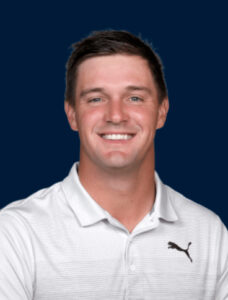
So how did DeChambeau tame Winged Foot, whose narrow fairways and punishing rough seemed designed to neutralize all but the straightest efforts? Was his length, strength and consistency the answer? Surely, but a deeper dive into the stats gives a bit more insight.
DeChambeau won the championship with a remarkable final round 67 to win by 6 strokes over Mathew Wolff who posted 75 (holding true to Winged Foot’s Open history of no third round leader besting a finish of 74). Only Bryson was under par for the day and for the final total.
The leader board: Bryson DeChambeau (-6), Matthew Wolff (E), Louis Oosthuizen (+2), Harris English (+3), Xander Schauffele (+4), Dustin Johnson (+5) and I add Rory McIlroy and Zach Johnson T8 (+6).
There was no shortage of long hitters in this group but still a mix. On officially chosen long drive holes, DJ was No. 1 at 333.8 yds, Wolf No. 2 at 333.6, Rory No. 6 at 328.5, DeChambeau No. 7 at 325.8, Schauffele No. 21 at 313.8, Oosthuizen No. 38 at 306.6 and Zach Johnson No. 61 of the 61players who made the cut, at 289.5. The tournament average was 310.5 yds.
There is an underappreciated category that includes “other” drives, that are a more random mix of holes in which drivers and lessor clubs might be used off of par 4’s and par 5’s, as some contestants play safe. Expectedly, that average lowers to 290.8 yards. I’ll personally dub this the “long and confident” category and it’s probably no surprise, that its leader was DeChambeau at 314.0, over 7 yards ahead of No. 2 Taylor Pendrith. Bubba Watson was No. 3 at 306.5, McIlroy No. 5 at 303.6, Wolff No. 6 at 302.4, Tony Finau No. 9 at 300.1, and surprising me, DJ was No. 16 at 295.7. Zach Johnson rose from the bottom to No. 46 at 286.4, likely hitting a driver the majority of the time. The longest drive of the week was by Conner Syme at 423 yards, DJ was second at 419, Wolff was 9th at 388, DeChambeau had the 13th longest at 385 (two of them in fact), with McIlroy at 373.
So, what about Driving Accuracy? The field averaged 39.7% of fairways hit. McIlroy was not only long, he was T3 at over 55%, English No. 8 at 51.79% and DJ was T16 at 46.4%. But note that DeChambeau was T26 at 41%, Wolff T49 at 33.9% and Schauffele T54 at 30.36%, with only three worse.
Strokes Gained Categories tell more of the story.
The Tour not only reports straight forward ShotLink data, it computes Strokes Gained (SG) in multiple categories with every shot by every player compared to an expected performance standard based on past Tour events with points added if better, or subtracted if worse than predicted, giving a truer indication than might Greens in Regulation or Putts per GIR in making player to player comparisons.)
The SG Putting category showed that No. 1 was Zach Johnson (last in driving distance but T8 overall). Xander was No. 11, DeChambeau No. 18, Rory No. 26, Wolff No. 29 and DJ No. 39. It’s obvious that Winged Foot was much more than a putting contest.
DeChambeau was No.1 in SG Tee-To-Green.Wolf was No. 2, DJ was No. 5 and McIlroy was No. 15, despite his long and accurate driving.
Part of Bryson’s success is told by the subcategory, SG Around-The-Green (inside of 30 yards). No. 1 was English, No. 2 was Schauffele, No. 3 was DeChambeau, No. 12 was Wolff, No.14 was Oosthuizen, while DJ was only No. 25 and McIlroy No. 29. So, DeChambeau’s short game did shine, but what about longer approaches to the greens? (This is where I had the most fun.)
From the Fairway at greater than 100 yards: Wolff was No. 1 in proximity to the hole, averaging 27 feet. DJ was 29th at 39 feet, DeChambeau 32nd at 40 feet and McIlroy 39th at 41 feet.
From the Fairway at greater than 200 yards: The average distance to the pin was 51 feet 5 inches. English was 3rd at 39 feet, Wolff was 5th at 41 feet, DJ was 33rd at 53 feet, DeChambeau was 50th at 60 feet and Oosthuizen 56th at 63 feet. (Wolff clearly excelled from the fairway, while DeChambeau, DJ, McIlroy and Oosthuizen, relatively not so much.)
Approaches from under 100 yards in the ROUGH, DeChambeau was 14th at 17 feet, while DJ was 19th at 27 feet and McIlroy was 50th at 64 feet. (Clearly, many shorter-hitting pros did quite well from rough within 100 yards of the green. These guys are all good).
Approaches from over 100 yards in the ROUGH: DJ was 1st at 42 feet, DeChambeau was 4th at 48 feet, Wolff was 18th at 58 feet and Rory was 30th at 61 feet. (Except for McIlroy, the longer hitters are getting traction).
Approaches from over 200 yards in the ROUGH: Oosthuizen was 1st at 23 feet, DJ 2nd at 36 feet, DeChambeau No. 3 at 45 feet, Wolff No. 22 at 76 feet, McIlroy 49th at 89 feet, and Zach Johnson 59th at 108 feet. (Wolf didn’t maintain the strong edge that he had from the fairway and Zach especially needs to hit fairways on the longest holes.)
Analysis
DeChambeau was reasonable “on” the greens, but he was near the top “around” the greens. Though his approaches from the fairway, not so much, surprisingly, even at lengthy distances. We all expected his prodigious driving, but what we witnessed were numerous “miracles” from out of the rough at longer distances, from where bogies and double bogies frequently arise. Which brings me to another observation. While Bryson was not the longest on selected driving holes, he had the longest carry. You probably noticed that on a number of drives into the fairway, other players’ drives landed well short of his but rolled near and on occasion past his ball. The same players were far back when both landed in the rough. DeChambeau has matched his 5.5 degree driver to his angle of attack and swing speed to achieve a carry distance that may have actually given him advantage in this Open, as most of the field also played from the distant rough.
The bottom line, DeChambeau was strong, confident and avoided hitting two bad shots in a row. Over the tournament he had two eagles (1st), 13 birdies (4th), only 11 bogies (1st) and zero doubles (1st). McIlroy had no eagles and three doubles which is 10 shots right there. DJ had one eagle, one double but five less birdies, in large part to his sub-stellar putting.
As DeChambeau said unassumingly in his post victory interview (along with noting that driver face COR’s and ball velocities have long been restricted), “You can’t regulate talent.” Whatever you think of the set up at storied Winged Foot, the final leaderboard was a very formidable one, and that suggests it was a valid test.
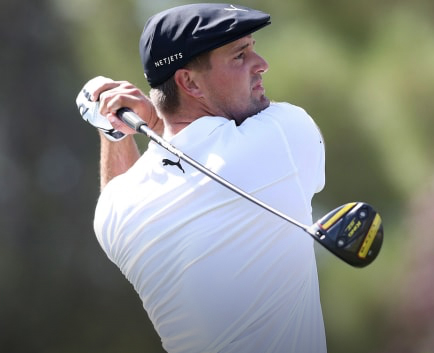
Yearly Tour Driving Statistics
The yearly leader in “average” driving distance on the U.S. PGA Tour has been officially recorded since 1980. It is based on two measured drives per round (whether in the fairway or not) on two preselected holes in opposite directions.
In 2020, Bryson DeChambeau achieved the longest ever mark of 322.1 yards (nudging Cameron Champ’s 322.0). The only other 320+ total was by Hank Kuehne with 321.4 yards back in 2003.
John Daly was the first to exceed 300 yards in 1997. He led the average every year from 1991 (288.9) through 2002 (306.8) except for Davis Love in 1994 (with 283.8).
Don Pohl led with 274.3 yards in 1980 and 280.1 yards in 1981. Others through 1990 included Bill Calfee, Curt Byrum, Bill Glasson, Andy Bean, Davis Love, John McComish, Steve Thomas, Ed Humenik and Tom Purtzer with none over 285.7 yards.
Bubba Watson led in 06, 07, 08, 12 and 14 (his highest at 319.6 yards in 2006). Also on the list are Scott Hend, Robert Garrigus, J.B. Holmes and Luke List (“only” 306.3 yards in 2013). Dustin Johnson led in 2015 (317.7 yards), Rory McIlroy in 2017 and 2018 (319.7 yards) and Cameron Champ in 2019 (317.9 yards).
The numbers are clearly low through the 1980s with some progression in the 90s with a “jump” in the early 2000’s associated with equipment changes. But there have been some very long measurements from years like 2003 and 2006 and Rory and Dustin recorded lower official numbers than than they did 3 to 5 years ago. Obviously, there are numerous factors that influence the “average” numbers which don’t reflect some of the times when the bombers really let it fly.
On the women’s side, the longest LPGA driver so far in 2020 is Bianca Pagdanganan at 287.5 yards, followed by Maria Fassi (283.2), Anne van Dam (282.3), Jessica Korda (272.9) and Nelly Korda (272.7) who round out the top five. Notables Lexi Thompson (No. 7-271.6), and Brook Henderson (No. 15-265.8). But the top five money leaders, Danielle Kang, Inbee Park, Minjee Lee, Austin Ernst and Jasmine Suwannapura aren’t in the top 40 in averge driving distance! Long hitting Nelly Korda is 6th on the money list. Kang is 50th in driving distance.
Honorable mentions for single holes go to a 787-yard drive (you read that right) in the 1992 Texas Open off of a downward-sloping cart path by Carl Cooper on a 456-yard par four (ouch- he took three shots to get back to the green and two-putted for a double) and to Mike Austin’s 515-yard drive in the 1974 Senior’s Open with a 35-mph helping wind. There are numerous drives in the mid to upper 400s on the 18th at the Plantation Course at Kapalua.
HOW ABOUT THE AMATEURS
A 2016 study by Golf Digest of amateur golfers for distance by handicap or age (unfortunately they didn’t report both together), yielded the following results:
Driver distance by Handicap:
0-5 (14.6 percentage of group) – 251 yards,
5-10 (21.94 percentage) – 231 yards,
10-19 (39.42 percentage) – 215 yards,
19-28 (17.28 percentage) – 196 yards,
28+ (6.73 percentage) – 177 yards
Driver distance by age (irrespective of handicap):
20-30 (12.97 percentage) – 239 yards
30-40 (25.76 percentage) – 231 yards
40-50 (24.17 percentage) – 221 yards
50-60 (21.42 percentage) – 212 yards
60+ (15.69 percentage) – 196 yards
Overall median distance: Driver-219, 3W-187, 7 iron- 133, PW- 74
The search for more distance in golf has existed from the beginning at all levels. Frank Stranahan was one of the first notable Tour professionals to make fitness a priority. Since DeChambeau, there seemingly is no end in sight.
